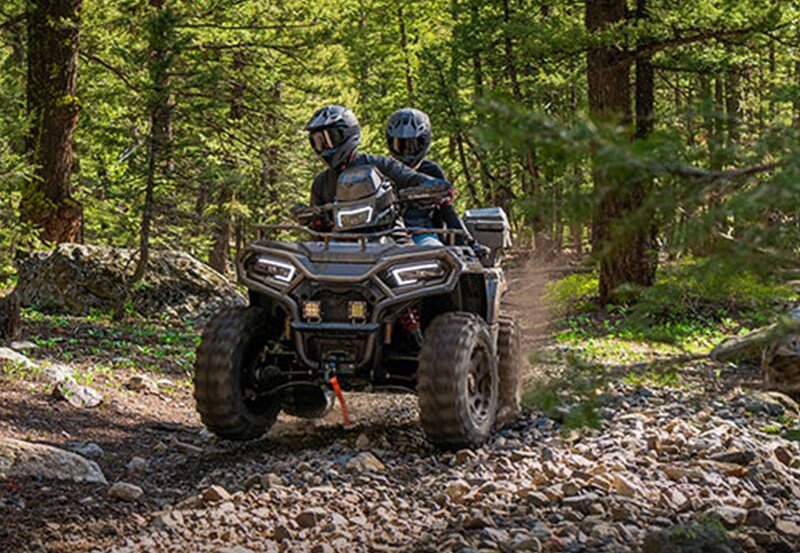Getting your snowmobile’s track adjusted correctly doesn’t have to be complicated. In this guide, we’ll show you the tools, step-by-step instructions, and troubleshooting tips for all major brands — Polaris, Ski‑Doo/Lynx, Arctic Cat, Yamaha, and more. If you do it right, your snowmobile will run great quickly. Why Track Tension Matters Track tension directly affects […]

Gas vs Electric ATVs: A Detailed Comparison
The ATV world is entering a new era. Electric ATVs are growing in popularity, challenging traditional gas-powered models. For recreational riders, choosing between a gas ATV and an electric ATV involves weighing trade-offs in performance, cost, maintenance, and environmental impact. This article dives deep into the key factors to help you choose.
Table of Contents
Gas vs Electric ATVs
Ride Feel & Performance
Gas ATV Highlights

2025 Polaris Sportsman 570
- Raw power and speed: A typical mid-range ATV like the 2025 Polaris Sportsman 570 packs around 44 HP from its ProStar 4-stroke 570 cc engine.
- Thrilling throttle response: Gas engines build rpm and come alive as you rev them. Off the line, acceleration is impressive—revving and roaring feel powerful.
- Community favorites: Many riders on forums like Reddit praise the Sportsman 570 as “powerful” and “nimble,” ideal for mixed terrain.
Electric ATV Highlights

DRR EV Stealth
- Instant torque: The motor delivers full power instantly; no need to rev or shift gears. Models like the DRR EV Stealth offer smooth, electric thrust ideal for tight trails.
- Quiet operation: Electric ATVs run with minimal noise, perfect for camping, hunting, or enjoying nature in silence.
- Heavier but stable: Electric quads weigh more due to batteries (typically ~200 kg), but the low battery placement improves stability and handling.
Range & Refueling vs. Recharging
Gas ATV Advantages

quick refueling
- Quick refueling: Fill your tank in minutes. Expect 80–100 miles of range per tank—a major advantage for long rides or multi-day adventures.
- Consistent consumption: With typical fuel efficiency of 10–20 MPG, you’ll spend roughly $3–$4/hour riding, based on 2025 U.S. gas prices around $3.75/gal.
Electric ATV Advantages
- Decent daily range: The DRR EV Stealth, for example, offers about 35 miles per charge, with a top speed near 35 mph. Charging takes around 6 hours on 120 V.
- Lower energy cost: Charging 4 kWh at $0.15/kWh costs just $0.60, versus dollars for a gallon of gas—huge savings per mile.
- Home-friendly charging: Plug into a household outlet overnight. Optional 240 V cuts charging time roughly in half. No fast charging available yet.
Cost Breakdown: Purchase, Fuel/Energy & Maintenance
Upfront Cost
- Gas ATVs: Most models cost $6,000–$11,000. The Polaris Sportsman 570, for instance, is priced around $10,999. More powerful or specialty models run higher.
- Electric ATVs: The DRR EV Stealth is about $9,299. Prices climb if you add higher-capacity batteries or premium components. In Europe, VAT can push prices higher.
Operating Costs
- Gas fuel cost: Expect to spend $3–$4 per hour riding.
- Electric power cost: A full charge is usually under $1, translating to mere tens of cents per hour—significantly cheaper in the long run.
Maintenance & Repairs
Gas ATVs require oil changes, filters, spark plugs, coolant checks, and engine servicing. Long-term maintenance can add thousands in costs.

Electric ATV maintenance
Electric ATVs are simpler under the hood—no oil, spark plugs, or filters. Brake and suspension are the main maintenance items. Battery lifespan is typically 3,000+ charge cycles, meaning minimal long-term cost.
Environment & Noise
Environmental Impact
Gas ATVs emit CO₂ and pollutants—one full-day ride can produce over 20 kg of CO₂. This matters in protected areas.
Electric ATVs: Zero tailpipe emissions. They’re quieter to produce lower noise pollution and reduce environmental disturbance. Charging emissions depend on your grid, but electric efficiency is high.
Noise Comparison
Gas ATVs roar at around 90–110 dB, loud enough to disturb wildlife and damage hearing.
Electric ATVs hum at approximately 60–70 dB, similar to lawnmowers or conversation—much friendlier in natural settings.
Real-World Use Cases
| Feature | Gas ATV | Electric ATV |
|---|---|---|
| Purchase Price | $6,000–$11,000+ | $9,000–$12,000+, premium higher |
| Range | 80–100 miles per tank | 30–40 miles per charge |
| Refuel/Recharge | Minutes | 4–8 hours (120V); faster on 240V |
| Running Cost | $3–$4/hour | Under $1/charge |
| Maintenance | Regular service needed | Minimal, simple upkeep |
| Ride Noise | Loud engine noise | Whisper-quiet |
| Eco & Trail Impact | Highest emissions/noise | Lowest emissions/noise |
| Ideal Use | Long rides, remote terrain | Trails, camping, eco-friendly zones |
- Gas ATV: Ideal for long-distance rides, remote areas, and heavier tasks. Their wide availability and quick refueling make them a reliable choice.
- Electric ATV: Perfect for shorter outings, environments requiring quiet operation (like campgrounds or wildlife areas), and lower maintenance. Great for learning and daily fun.
Final Verdict: Which One Is Best?
Choose a Gas ATV if…
- You go on long-distance or multi-day rides
- Refueling convenience is key
- You need a rugged machine for heavy terrain
Choose an Electric ATV if…
- You prioritize quiet, eco-friendly riding
- You usually take shorter, local trips
- You want lower running/maintenance costs
For many riders, owning both types could be ideal: a gas ATV for long adventures and an electric ATV for nearby, eco-friendly fun.
What Does 2025 Bring?
Battery improvements will deliver lighter packs, faster charging, and longer range.
Government incentives (especially in Europe) are increasing, pushing buyers toward electric options.
Major brands like Polaris, Yamaha, Honda, and Can-Am are actively developing and testing electric ATV models—expect more affordable, mass-market e-quads soon.
By the end of 2025, you might find electric ATVs priced near $7,000 with 50+ mile range and 2–3 hour charging capability, making them a strong competitor to gas bikes.
Safety Reminder
- No matter which type you choose, safety always comes first:
- Wear a helmet, eye protection, gloves, and appropriate gear.
- Learn trail etiquette—don’t race near others, respect wildlife and property.
- Take basic riding lessons if you’re a beginner.
Final Thoughts
Gas and electric ATVs each offer unique advantages.
Gasoline ATVs provide long range, quick refueling, and time-tested power and toughness. Electric ATVs deliver instant torque, quiet operation, and lower running costs – at the expense of shorter range and longer recharge times.
Maintenance on an e-ATV is typically easier and cheaper (no oil changes), and environmental impact is much lower during use. Price-wise, gas ATVs are generally cheaper to buy, but in many cases electric models can save money over years of ownership.
The right choice depends on your riding style and values. If you ride remote trails for days at a time, a gas quad still offers unmatched freedom. If you do shorter rides, care about noise or emissions, and like new tech, an electric ATV could be the future of trail riding.
With rapidly advancing technology and more models coming each year, 2025 is a pivotal time – the electric ATV market is growing fast, and even traditional ATV fans are noticing the new options out there.
You may also be interested in: Top 5 Best Electric ATVs For Kids

With over 10 years of experience working on cars and trucks Item Training Supervisor Richard Reina is known around the office as one of our technical experts & real an "automobile person".
His rate of interest began, in his very own words, "at the age of two when his father educated him the distinction in between a Chevy and a Ford. Since then it's been cars regularly."
As a serious lover of practically all things with a motor Richard can address nearly any kind of inquiry related to car upkeep, fixing, or restoration & is a fact professional in electric motor background.
Motorcycle riding is all about the sense of freedom, adventure, and thrill of the open road. But come on—being connected when you ride isn't always an easy thing. Whether you're riding with a buddy, navigating traffic in the city, or long-distance riding, effective communication is crucial. That's where the Fodsports T5 and T6 come in, […]
If you're looking for a new motorcycle intercom system this year, Fodsports has something exciting in store. The company has launched two new Bluetooth helmet intercoms: T1 and T1 Pro. Both models bring upgraded features, sleek design, and high-definition audio quality for riders who want to stay connected, entertained, and safe on the road. But […]
Fodsports T1 and T1 Pro: The Newest Bluetooth Intercoms for Riders. Whether you’re cruising on highways, exploring rugged trails, or commuting daily, clear communication is key. Fodsports is thrilled to launch its latest Bluetooth intercoms: the T1 and T1 Pro. Built for riders who demand reliability, versatility, and crystal-clear sound, these devices redefine how you […]
Many riders who aren't so tall or ladies just starting to ride bikes need to pick out the best Motorcycles for Short Riders and Women. They gotta look for three key things: a seat that's not too high up, a bike that's not too heavy, and something that looks good enough to give them confidence. […]
Fodsports FX 60C vs FX30C Pro: What's new techs are the FX 60C bringing to us? Fodsports is a brand worth-mention for helmet communication and video recording. This brand has established itself as a key player with its innovative Bluetooth camera intercom systems. Recently, Fodsports has released a new camera intercom, the FX 60C. How […]
